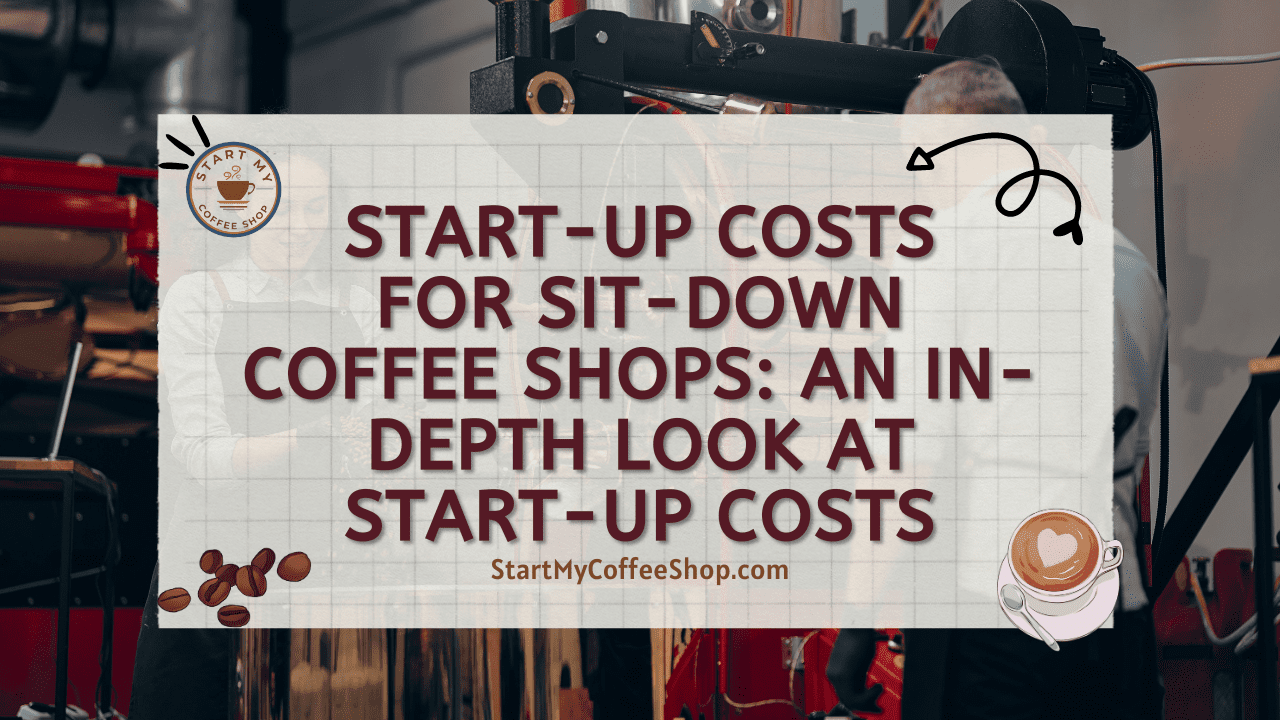Starting a sit-down coffee shop is a dream for many aspiring entrepreneurs. The aroma of freshly brewed coffee, the cozy ambiance, and the joy of serving a perfect cup to customers make it an exciting venture. However, before embarking on this caffeine-filled journey, it’s crucial to understand the financial aspects involved.
The typical start-up costs for a sit-down coffee shop include expenses such as equipment, lease or purchase of premises, renovations, permits, furniture, inventory, marketing, staff hiring, and initial operating expenses.
In this article, I will explore the start-up costs of opening a sit-down coffee shop.
Location and Lease Costs:
 When embarking on the journey of opening a sit-down coffee shop, one of the crucial initial steps is finding the perfect location. The location plays a significant role in the progress of your business, as it can determine the level of customer footfall and overall visibility. Ideally, you would want to secure a prime spot in a high-traffic area, where potential customers can easily access your coffee shop.
When embarking on the journey of opening a sit-down coffee shop, one of the crucial initial steps is finding the perfect location. The location plays a significant role in the progress of your business, as it can determine the level of customer footfall and overall visibility. Ideally, you would want to secure a prime spot in a high-traffic area, where potential customers can easily access your coffee shop.
However, it’s important to bear in mind that prime locations often come with a higher price tag. Lease expenses can vary widely based on factors such as the size of the space, the specific location, and the level of demand in the area. For instance, leasing a space in a bustling downtown area or a popular shopping district will likely cost more than a location in a quieter neighborhood.
When considering the overall lease costs, it’s crucial to factor in various expenses. These expenses include not only the monthly rent but also the security deposit, which is typically an upfront payment to secure the lease.
Additionally, there might be additional fees associated with the lease, such as standard area maintenance charges or utility costs. It’s essential to carefully review the lease agreement and consult with professionals to ensure that you have a clear understanding of all the associated costs.
While the lease costs for a prime location may be higher, it’s important to evaluate the potential return on investment. A high-traffic area can attract a larger number of customers, leading to increased sales and business growth. Conducting market research and analyzing the target customer demographic in the chosen location can help determine the viability and potential profitability of the venture.
Read more about Cost to Open Coffee Shop Average: From Concept to Cash Register
Equipment and Furnishings:
Creating a welcoming environment is essential for a sit-down coffee shop, and it requires careful consideration of the necessary equipment and furnishings. These elements contribute not only to the functionality of your coffee shop but also to the overall ambiance and customer experience.
First and foremost, investing in quality coffee equipment is crucial. This includes coffee machines, grinders, blenders, and refrigerators. These items are the backbone of your coffee shop and directly impact the quality and consistency of the beverages you serve. Opting for reliable, commercial-grade equipment ensures durability and efficiency in your operations.
In addition to the coffee equipment, you’ll need to consider other essential appliances such as toasters, ovens, and dishwashers, depending on the extent of your menu offerings. These appliances enable you to provide a range of food options to accompany the coffee and enhance the overall customer experience.
Beyond the functional aspects, the furnishings play a vital role in creating a comfortable and visually appealing atmosphere. Investing in comfortable seating, whether it’s chairs, booths, or a combination, allows customers to relax and enjoy their coffee. Consider the layout of your space and ensure that it allows for efficient customer flow while maintaining a cozy ambiance.
Tables and counters should be sturdy and practical, providing ample space for customers to enjoy their beverages and food. Display cases can showcase pastries, cakes, or other delectable treats, enticing customers to indulge. When selecting decor items, such as artwork, plants, or lighting fixtures, keep in mind your coffee shop’s theme or aesthetic to create a cohesive and memorable atmosphere.
While it’s important to prioritize quality when purchasing equipment and furnishings, it’s also essential to strike a balance with cost. Research and compare prices from different suppliers, keeping in mind factors such as warranties, customer support, and long-term maintenance costs. Consider purchasing refurbished equipment or exploring leasing options to manage initial costs effectively.
Renovations and Interior Design:
 When it comes to establishing a sit-down coffee shop, transforming a space into a cozy and inviting environment often involves renovations and interior design work. This process encompasses various tasks, including construction, plumbing, electrical wiring, painting, flooring, and lighting installations. The costs associated with these renovations depend on factors such as the existing condition of the space and the desired aesthetics you wish to achieve.
When it comes to establishing a sit-down coffee shop, transforming a space into a cozy and inviting environment often involves renovations and interior design work. This process encompasses various tasks, including construction, plumbing, electrical wiring, painting, flooring, and lighting installations. The costs associated with these renovations depend on factors such as the existing condition of the space and the desired aesthetics you wish to achieve.
Before diving into the renovations, a thorough assessment of the space is necessary. This helps identify any structural changes or repairs that need to be addressed. It may involve demolishing walls to create an open floor plan, constructing additional rooms or partitions, or making structural modifications to accommodate specific design elements. Seeking the guidance of professional contractors or architects is advisable to ensure that the renovations are carried out safely and in compliance with local building codes.
Plumbing and electrical work are critical aspects of any coffee shop renovation. This includes installing water lines for coffee machines and sinks, as well as ensuring proper electrical wiring to support equipment and lighting needs. Engaging licensed professionals for these tasks is essential to guarantee safety and functionality.
Painting the interior walls is an effective way to set the mood and enhance the ambiance of your coffee shop. Carefully selecting colors that align with your brand and desired atmosphere can greatly contribute to the overall experience of your customers. Flooring options such as hardwood, tiles, or polished concrete should be chosen based on durability, ease of maintenance, and the aesthetic appeal you want to create.
The role of lighting should not be underestimated in creating an inviting atmosphere. Incorporating a combination of natural light, overhead lighting, and accent lighting can highlight specific areas, such as the coffee bar or seating arrangements. The use of dimmable lighting can also provide flexibility to adjust the mood throughout the day.
To ensure a cohesive and appealing design, it is advisable to work with professionals who specialize in cafe or restaurant interior design. These experts can assist in translating your vision into reality by considering factors such as furniture layout, decorative elements, and the overall flow of the space.
Their expertise and experience in designing coffee shops can help create an atmosphere that resonates with your target customers, enticing them to relax, enjoy their beverages, and become regular patrons of your establishment.
When budgeting for renovations and interior design, it is important to obtain multiple quotes from contractors and designers. Evaluating their expertise, reviewing their past projects, and carefully considering the cost estimates will enable you to make an informed decision that aligns with your budget and vision for the coffee shop.
Licenses, Permits, and Legal Fees:
Operating a sit-down coffee shop involves navigating through a series of legal requirements, licenses, and permits. Ensuring that you have the necessary documentation in place is essential for running a legitimate and compliant business.
Here are some key licenses and permits you may need to obtain:
- Business License: Most jurisdictions require businesses to obtain a general business license. This license validates the legal operation of your coffee shop and often involves a fee payable to the local government.
- Health Permits: Coffee shops that serve food or beverages need health permits to ensure compliance with health and safety regulations. These permits typically involve inspections of your establishment to ensure proper sanitation, handling of ingredients, and food storage practices.
- Food Handling Permits: If your coffee shop serves food items, you may need specific permits related to food handling and preparation. These permits ensure that you and your staff have received proper training in food safety and that your establishment follows appropriate hygiene practices.
- Liquor License: If you plan to serve alcoholic beverages in your sit-down coffee shop, you will need to obtain a liquor license. This involves additional regulations and may vary depending on the jurisdiction. It’s important to research the specific requirements and procedures for obtaining a liquor license in your area.
Apart from licenses and permits, legal fees should also be considered. These expenses may include the cost of drafting contracts, such as lease agreements or vendor contracts, as well as protecting your intellectual property by obtaining trademarks for your brand name or logo. Consulting with an attorney who specializes in business law can help you navigate through the legal aspects and ensure compliance with local regulations.
Read more about Cost to Open Coffee Stand: Evaluating the Financial Commitment to a Coffee Stand
Inventory and Supplies:
To meet the demands of your coffee-loving customers, it is crucial to maintain a well-stocked inventory of essential ingredients and consumables in your sit-down coffee shop. This includes a variety of coffee beans, tea leaves, syrups, milk, sugar, and other beverage ingredients that cater to different tastes and preferences.
Quality is key when it comes to selecting your coffee beans and tea leaves. Consider sourcing from reputable suppliers who offer a range of options such as single-origin beans or specialty blends. This ensures that you can provide a diverse and flavorful menu to satisfy the varying preferences of your customers.
In addition to the main beverage ingredients, it is important to have an ample supply of consumables. This includes cups, lids, stirrers, napkins, and other items necessary for serving and enjoying the beverages. These items should be of good quality and suitable for the type of drinks you offer. Opting for eco-friendly or biodegradable options can align with the growing sustainability concerns of many customers.
Establishing strong relationships with suppliers is vital to ensure a steady and reliable inventory. Regularly communicate with your suppliers to discuss your needs, monitor stock levels, and plan for future orders. By fostering these relationships, you may have the opportunity to negotiate favorable pricing terms, discounts, or volume-based incentives, which can help optimize costs in the long run.
Efficient inventory management is also essential to avoid waste and minimize the risk of stockouts. Implementing inventory tracking systems or utilizing software solutions can help you monitor stock levels, track sales trends, and automate reordering processes. This allows you to maintain adequate inventory levels, reduce the risk of running out of key items, and avoid unnecessary expenses associated with overstocking.
As part of your cost optimization strategy, regularly review and analyze your inventory needs. Assess the popularity of different beverages and adjust your stock levels accordingly. Monitor customer preferences and adapt your offerings to meet their evolving tastes. By staying attuned to market trends and customer feedback, you can fine-tune your inventory management to optimize costs and enhance customer satisfaction.
Marketing and Advertising:
In the competitive landscape of the coffee shop industry, effective marketing and advertising strategies play a pivotal role in attracting customers and building a loyal following. To make your sit-down coffee shop stand out, it is crucial to invest in comprehensive marketing efforts that encompass both offline and online channels.
Creating a strong brand identity is the foundation of your marketing endeavors. This involves developing a unique brand name, designing a captivating logo, and defining your coffee shop’s overall aesthetic and messaging. A well-crafted brand identity helps differentiate your business from competitors and resonates with your target audience.
Offline marketing materials such as menus, signage, and promotional materials are vital for engaging customers within your physical space. Professional design and high-quality printing of these materials are crucial for making a positive impression on customers. Eye-catching signage can entice passersby to step inside your coffee shop, while well-designed menus can showcase your offerings and encourage customers to try new beverages or treats.
In today’s digital age, online marketing strategies are equally important for reaching a wider audience. Start by developing a professional website that showcases your menu, ambiance, and unique selling points. Optimize your website for search engines through search engine optimization (SEO) techniques, making it easier for potential customers to find your coffee shop online. Establishing a strong social media presence on platforms like Instagram, Facebook, or Twitter allows you to engage with customers, share updates, and promote specials. Utilize these platforms to showcase the aesthetic appeal of your coffee shop, interact with customers, and build an online community around your brand.
Investing in online advertisements can significantly boost your visibility and reach. Platforms like Google Ads or social media advertising provide targeted options to reach specific demographics or geographic areas. By allocating a portion of your marketing budget to online advertising, you can drive traffic to your website, increase brand awareness, and attract new customers.
To ensure sustained visibility and customer engagement, it is crucial to budget for ongoing marketing campaigns. Regularly evaluate the performance of your marketing activities, track customer responses, and make adjustments as necessary. This may involve running seasonal promotions, collaborating with local influencers, or hosting community events to encourage customer loyalty and generate positive word-of-mouth marketing.
Remember, effective marketing requires a cohesive and consistent approach across all channels. Maintaining a strong and recognizable brand presence both online and offline will maximize your visibility and help forge strong connections with your target audience.
Staffing and Training:
 When budgeting for your coffee shop, consider the various roles required, such as baristas, servers, cashiers, and kitchen staff. Take into account local labor laws and regulations to ensure compliance with wages, benefits, and working conditions. This includes understanding minimum wage requirements, overtime regulations, and any additional benefits mandated by law.
When budgeting for your coffee shop, consider the various roles required, such as baristas, servers, cashiers, and kitchen staff. Take into account local labor laws and regulations to ensure compliance with wages, benefits, and working conditions. This includes understanding minimum wage requirements, overtime regulations, and any additional benefits mandated by law.
Investing in staff training programs is essential to uphold quality standards and provide exceptional customer service. Training should encompass various aspects, including coffee brewing techniques, menu knowledge, customer interaction skills, and food safety protocols. By equipping your team with the necessary skills and knowledge, you enhance their ability to create positive experiences for customers, leading to increased customer satisfaction and loyalty.
Furthermore, creating a positive work culture is crucial for staff morale and retention. Allocate resources to promote a supportive and inclusive environment, where employees feel valued and motivated. This can include team-building activities, recognition programs, or providing opportunities for growth and advancement within the company. A happy and engaged staff is more likely to deliver exceptional service and contribute to the overall performance of your coffee shop.
Remember to regularly review staffing needs based on customer demand and adjust your budget accordingly. Assess the effectiveness of your training programs and seek feedback from both customers and staff to identify areas for improvement.
Read more about Running a Coffee Shop Costs: A Deep Dive into Financial Considerations
Insurance and Utilities:
Protecting your business and employees is of paramount importance when running a sit-down coffee shop. Allocating funds for insurance coverage is essential to safeguard against unforeseen events and mitigate potential risks.
Liability insurance is crucial for protecting your business from claims and lawsuits arising from accidents or injuries that may occur on your premises. It provides coverage for legal fees, medical expenses, and damages, offering you peace of mind and financial protection.
Workers’ compensation insurance is necessary to ensure that your employees are protected in the event of work-related injuries or illnesses. It provides coverage for medical expenses, lost wages, and rehabilitation costs, while also offering liability protection for your business.
Property insurance safeguards your coffee shop against potential damages to the building, furniture, equipment, and inventory caused by incidents like fire, theft, or natural disasters. This coverage allows for timely repairs or replacements, minimizing downtime and ensuring the continuity of your business operations.
In addition to insurance, consider utility costs when budgeting for your sit-down coffee shop. These include electricity, water, gas, and internet connection expenses. The amount will vary depending on the size of your establishment, equipment usage, and operational hours. Efficient energy management practices, such as installing energy-efficient appliances or optimizing lighting systems, can help reduce utility costs in the long run.
Initial Operating Expenses:
During the initial months of operating a sit-down coffee shop, having sufficient funds to cover various operating expenses is crucial for a start. Allocating a buffer for these expenses is essential to ensure a smooth launch and navigate any unforeseen challenges that may arise.
Inventory restocking is an ongoing expense that involves replenishing coffee beans, tea leaves, syrups, milk, sugar, and other beverage ingredients. Having a well-stocked inventory is vital to meet customer demands and maintain a consistent quality of offerings. Allocating funds for inventory ensures that you can provide a wide selection of beverages and prevent any service disruptions.
Rent is a significant expense for a sit-down coffee shop. It’s important to budget for monthly lease payments and factor in potential rent increases over time. Ensuring that you have sufficient funds to cover rent allows you to secure a prime location and maintain a steady presence in a high-traffic area, attracting more customers and generating revenue.
Utilities, such as electricity, water, and gas, are ongoing expenses that need to be accounted for. These costs will vary depending on the size of your coffee shop and its energy usage. Budgeting for utilities helps avoid unexpected surges in expenses and allows for efficient usage management through practices like installing energy-saving equipment or optimizing operational hours.
Marketing campaigns are crucial for attracting customers and creating awareness of your coffee shop. Allocating funds for ongoing marketing initiatives, such as online advertisements, social media promotions, or local events, help maintain visibility and customer engagement.
Maintenance, repairs, and unexpected costs should also be considered in your budget. Equipment may require servicing or repairs, and unexpected issues may arise that need immediate attention. Having a financial cushion allows you to address these unforeseen expenses without disrupting your operations or compromising customer experience.
Summary
Starting a sit-down coffee shop is an exciting venture that requires careful consideration of the associated start-up costs. From location and lease expenses to equipment, furnishings, and marketing efforts, each element plays a crucial role in establishing a coffee shop.
By understanding and planning for these costs, aspiring coffee shop owners can embark on their caffeine-fueled journey with confidence, creating a haven for coffee enthusiasts and fostering a thriving business for years to come.
So, roll up your sleeves, brew that perfect cup, and embark on an exhilarating journey into the world of sit-down coffee shops!
Frequently Asked Questions
Question: What are the essential equipment and furnishings needed for a sit-down coffee shop?
Answer: The key kit includes coffee machines, grinders, blenders, refrigerators, and display cases. Furnishings comprise seating, tables, counters, and decor. Costs will vary based on quality, brand choices, and the size of the coffee shop.
Question: Are there any legal requirements or permits needed to open a sit-down coffee shop?
Answer: Yes, operating a sit-down coffee shop entails obtaining licenses and permits such as business licenses, health permits, and potentially liquor licenses if alcohol is served. It’s crucial to research and comply with local regulations to ensure legal operations.
Question: How important is marketing for a sit-down coffee shop, and what are the associated costs?
Answer: Marketing is vital for attracting customers and building a brand. Costs will depend on the chosen strategies, such as website development, social media presence, advertising, and printed materials. Allocating a budget for ongoing marketing efforts is essential.
To learn more on how to start your own coffee shop checkout my startup documents here
Please note: This blog post is for educational purposes only and does not constitute legal advice. Please consult a legal expert to address your specific needs.

Hi! I’m Shawn Chun
My adventure in coffee began when I first launched my first coffee shop back in the early 2000s. I had to figure out so many things on my own and to make it worse within 2 years of opening two large corporate coffee chains moved in just blocks away from me!
As I saw smaller and even some larger coffee shops in the neighborhood slowly lose customers to these giant coffee chains and slowly close up shop, I knew that I had to start getting creative…or go out of business.
I (like you may be) knew the coffee industry well. I could make the best latte art around and the foam on my caps was the fluffiest you have ever seen. I even had the best state-of-the-art 2 group digital Nuova Simonelli machine money could buy. But I knew that these things alone would not be enough to lure customers away from the name brand established coffee shops.
Eventually, through lots of trial and error as well as perseverance and creativity I did find a way to not only survive but also thrive in the coffee/espresso industry even while those corporate coffee chains stayed put. During those years I learned to adapt and always faced new challenges. It was not always easy, however, in the end, I was the sole survivor independent coffee shop within a 10-mile radius of my location. Just two corporate coffee chains and I were left after that year. All told the corporate coffee chains took down over 15 small independent coffee shops and kiosks and I was the last one standing and thriving.
Along the years I meet others with the same passion for coffee and I quickly learned that it is not only “how good a barista is” that makes a coffee shop successful, but the business side of coffee as well.
Hence why I started this website you are on now. To provide the tools and resources for up and coming coffee shop owners to gain that vital insight and knowledge on how to start a coffee shop successfully.
Stick around, browse through my helpful blog and resources and enjoy your stay! With lots of LATTE LOVE!
Shawn






